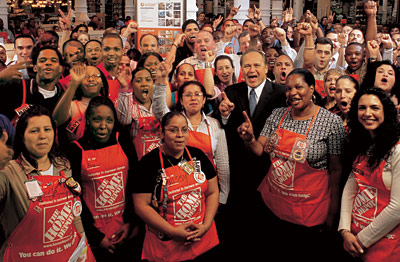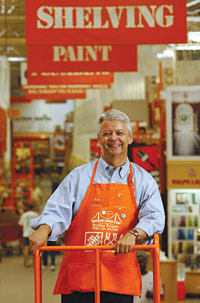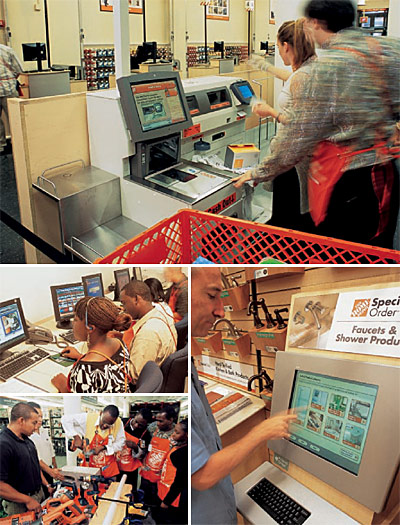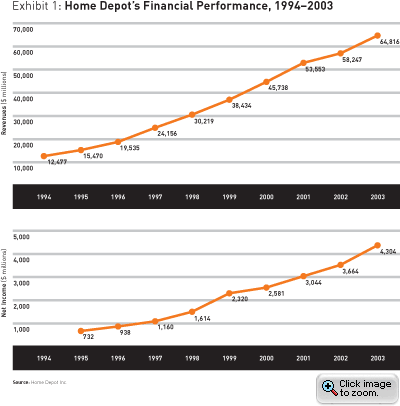Winning Hearts and Minds at Home Depot
Bob Nardelli’s pursuit of perfection, 3 billion human interactions per year.
(originally published by Booz & Company)At a Home Depot store just outside Atlanta, a vacuum cleaner made by Dyson, the U.K. appliance maker famous for its design, sits on a small square of gray carpet at the edge of an aisle. The display is so unobtrusive, anyone passing by might think a store assistant had placed it there as an afterthought.
But little at Home Depot Inc. happens by accident. Rather, the positioning of the Dyson vacuum shows just how firmly Chairman, President, and Chief Executive Officer Robert L. Nardelli and his passion for precision processes and meaningful metrics have taken hold at the retailer. In-store research has revealed that the chain can sell more vacuums if they are placed on a patch of carpet — not in every one of its 1,850 stores, mind you, just in the stores where vacuum sales underperform sales targets. The research-based strategy signals how far management is willing to go to get inside consumers’ minds, and influence their thinking, just at the moment they’re primed to make a purchase.
 |
|
CEO Robert L. Nardelli (wearing the suit) celebrates the opening of New York City's Chelsea store with its salespeople. |
|
Photograph by Peter Gregoire |
The vacuum-on-the-carpet idea is the product of a company-wide Six Sigma program, one of Mr. Nardelli’s favorite management disciplines. Six Sigma originated as part of the total quality movement’s assault on manufacturing defects. But many of its most ardent proponents — among them GE’s legendary CEO Jack Welch (Mr. Nardelli’s former boss) — use the concept as a way to push employees in every job to strive for perfection.
Fearful of alienating workers, however, it was only after three years at Home Depot that Mr. Nardelli felt comfortable introducing Six Sigma. “Otherwise, it would have been me pushing it down everyone’s throats, and it would have been looked at as Bob’s wild idea,” he says. “At the beginning I could see everyone was scared I’d speak in Six Sigma tongue.”
Ensuring that disciplines like Six Sigma support Home Depot’s human capital strategy is at the core of Mr. Nardelli’s leadership approach. Of course, executives must be attentive to the efficiency of strategic processes: making the supply chain as lean as it can be, using scale to unseat competitors, leveraging IT to reduce costs, and finding the right marketing formulas. But senior executives are starting to realize that unless they can get the people in their organizations mobilized and energized in support of business priorities, success will elude them.
Whether a company is in search of double-digit growth, culture change, or blockbluster products, the importance of the human side of transformation can never be underestimated in the execution of its strategy. As the dean of management excellence, Peter Drucker, wrote in a 1994 Atlantic Monthly essay: “The essence of management is not techniques and procedures. The essence of management is to make knowledge productive.”
Every day, the degree to which physical assets have become commodities becomes clearer to executives. The competitive edge lies in human capital. “Bricks and mortar, anyone can buy,” says Sue Meisinger, president of the Society for Human Resource Management. “Information and technology are accessible. What distinguishes a business these days are its people.”
Nowhere is this truer than at Home Depot. This is a company that fundamentally relies on the quality, not just the quantity, of human interactions to stay on top in its business. Its 325,000 shop assistants interact with customers about 3 billion times per year, and often at a very personal level — helping them select items like kitchen sinks and toilets. Every month, the volume of activity rises. The retailer opens a new store every 48 hours, and receives more than 10 million job applications every year.
Filling positions with quality people is a challenge, and no one knows this better than Mr. Nardelli, the 56-year-old CEO. “It takes a certain kind of person to put up with the demands of the retail business,” he says.
Few companies, even in retail, appear as dependent as Home Depot on their employees to close a transaction. Smart, courteous, and efficient employees are important to almost any company. But at Home Depot, salespeople need to go a step further to provide meaningful solutions to each individual — whether they are serving the classic “do it yourself” customer the company has always prized, or the newer “do it for me” kind of customer.
“When you think about Starbucks, 90 percent of the people who go in there already know what they’re getting,” says Eric Bosshard, who follows Home Depot for FTN Midwest Research, an institutional equity research firm based in Cleveland. “At Wal-Mart, you don’t need someone to explain to you how the latest laundry detergent is used. At Home Depot, that’s not the case. Shoppers go there as much for advice as for the product. Service is really key.”
That’s one reason Mr. Nardelli is promoting a decentralized human resources model, where HR professionals based in the stores rather than in a head-office human resources department handle training of store personnel. The company has also established the Leadership Development Institute, modeled on GE’s Leadership Center at Crotonville, N.Y., which includes training for up-and-coming executives as well as a demanding 24-month leadership program for fast-track store managers. A one-week intensive course for district and sales managers uses common business school teaching techniques such as computer simulations and role-playing; assistant store managers are also attending the course.
“One of the biggest responsibilities I have is to take care of the human capital as well as the physical capital side. We’re only as good as our worst shop assistant. You need to get together a group of people with real leadership skills and put them to work,” Mr. Nardelli says.
Hard-Charging Change
When Bob Nardelli took over from Home Depot’s founders, Bernard Marcus and Arthur Blank, he knew they would be a tough act to follow. An outsider with no retail experience entering a close-knit company, Mr. Nardelli had a background that included leading divisions of large multinational manufacturing companies — General Electric Company and the Case Corporation — that made things like appliances, construction equipment, and transportation systems, and that had very different cultures from Home Depot’s. Moreover, he knew his exacting management and leadership style contrasted sharply with the nonconformist style of Messrs. Marcus and Blank.
In his favor, though, Mr. Nardelli, a hard-charging football and NASCAR racing enthusiast, was taking over a firm that was a winner with an enviable record of growth and profitability. From its beginnings in 1979 as a single-store and then a three-store operation in Atlanta, Home Depot never seemed to have a bad year. Even during the 1991–92 U.S. recession, sales kept soaring, and Home Depot kept opening more stores.
The company is now the second-largest retailer in the U.S. (behind Wal-Mart) and the largest home improvement retailer in the world. (See Exhibit 1.)
Although he knew that connecting with the people of Home Depot would be a challenge, Mr. Nardelli was not prepared for the cold reception that awaited him when he arrived at Atlanta headquarters. He was fresh with a new leader’s enthusiasm for sharing ideas and for change, but employees didn’t feel the same way. Why should they? The company was on a roll, morale was good, and there was no burning platform to ignite a desire to transform.
Then there were the iconic founders, idolized by both investors and employees for their innovative retail ideas and their irreverence. Home Depot was famous for its warehouselike stores, where shoppers were expected to find their own way around. If they got lost, all the better, Home Depot’s founders believed, because then the shoppers would come across more things they needed to buy.
Home Depot was a haven for independent-minded employees just like “Arthur and Bernie” — people who got things done, but didn’t always play by traditional corporate rules. Store managers were actually encouraged to make decisions independently of headquarters. According to Home Depot old-timers, if employees received a memo from Atlanta, they would tear it up. Voice mails from head office executives were often immediately erased. The company embraced with zeal hip management philosophies like flat and nimble organization and worker empowerment.
Home Depot was widely viewed as a fun place to work. Indeed, this is a company especially rich in amusing corporate lore. Legend has it that Ross Perot, the larger-than-life Texas businessman, former presidential candidate, and founder of Perot Systems, had been ready to furnish $2 million in seed money for Home Depot, until he heard that Mr. Marcus wanted to use his four-year-old Cadillac as his corporate car. The blunt Mr. Marcus told the blunt Mr. Perot to go jump in a lake. Home Depot employees still chuckle over the billions Mr. Perot would have made had he only kept his automotive opinions to himself. The seed money would now be worth about 70 percent of Home Depot.
In a culture where employees revered the founders’ casual personal styles and leadership, no doubt a new CEO from a perfectionist company like GE must have seemed threatening. People working at Home Depot in 2000 say the tension upon Mr. Nardelli’s arrival was palpable. “You’ve got to realize what energy and excitement there was at Home Depot back then,” says Tom Taylor, currently Eastern division president. “Store employees would talk about Bernie and Arthur as if they were their grandfathers. You’d hear managers ask their workers: ‘How do you think Bernie and Arthur would feel about that?’ Just the question would keep everyone in line.”
The suddenness of Mr. Nardelli’s courting by Home Depot didn’t help. Mr. Nardelli received a call from a headhunter for the home improvement chain only a few days after Jack Welch told him he wouldn’t be the next CEO of GE. Mr. Nardelli, who had spent nearly his entire career striving for General Electric’s top job (his last post was as head of GE Power Systems), was stunned. But he did not stay down for long. On the following Tuesday, Bernie Marcus flew to meet with Mr. Nardelli at GE Power Systems’ offices in Schenectady, N.Y. He and Mr. Blank had already been quietly looking for someone to whom they could hand over the reins of the company because they saw trouble brewing beneath the retailer’s glossy surface. So they swooped down to grab Mr. Nardelli before someone else did.
The news came as a shock to Home Depot employees. “Arthur was still young, in his 50s, and we had no reason to think he would leave,” Mr. Taylor recalls. “If any of us had vaguely considered that one day there’d be a new CEO, we would have expected an internal hire.” Indeed, few companies have inspired the kind of commitment to a vision that Home Depot has. There was a clear Home Depot way of doing things, and the less those ways made sense to outsiders, the more workers clung to their company traditions.
Mr. Nardelli, an energetic, compactly built man with a quick step and a ready smile, certainly appreciated Home Depot employees’ ardor for their corporate culture. “I worked for an industrial icon, so was sensitized to that,” he said, as he looked from his window at the Home Depot store across from headquarters during an interview in July 2004. Yet the employees’ hostility to change upon his arrival didn’t only make Mr. Nardelli uncomfortable; he knew it was dangerous for the company. Home Depot had reached a turning point. In 2000, rival big-box retailer Lowe’s was starting to pose a real threat to Home Depot. The well-lit, clean Lowe’s stores were especially appealing to women, and Home Depot was starting to feel the pinch.
Mr. Nardelli needed Home Depot employees to understand the looming Lowe’s threat, and to be as motivated as he was to beat it. Getting employee support for his new strategy and management ideas, as well as training people at many levels to become better leaders and disciplined managers, were Mr. Nardelli’s primary areas of focus, and he had the full support of the founders. Mr. Marcus sat in on important meetings with employees and financial analysts to help Mr. Nardelli ease his way into his new role and gain employees’ trust. But even with Mr. Marcus by his side, Mr. Nardelli’s suggestions didn’t go over well, especially with store staff. He wanted to spruce up the stores, improve signage, and add such amenities as water fountains and food stands. To many store workers, all this seemed sacrilegious.
 |
|
Dennis Donovan, executive vice president of human resources
Photograph by Curtis Compton |
Recognizing that he had to win the hearts and minds of Home Depot’s people, Mr. Nardelli determined that one of his first moves as CEO would be to hire a highly visible, experienced human resources executive to co-lead the charge for change with him. He knew exactly the person to ask: Dennis Donovan, a former colleague. The two men had worked closely together for years at GE Power Systems. When Mr. Nardelli was the unit’s president, Mr. Donovan was the vice president of HR. He was known as a tough but highly motivational leader who had done his share of human transformations in several parts of GE. He knew what Home Depot was up against. “I’ve seen it many times. When you ask people in an organization to change, the reaction is to say, ‘We’re different’ and ‘You don’t understand,’ ” says Mr. Donovan. “To which I respond, ‘I do understand, and you’re not different.’ ”
Mr. Nardelli offered Mr. Donovan the position of executive vice president of human resources, and employees were told that his job would be one of the most influential posts at Home Depot. In a concession as symbolic as it was compelling for Mr. Donovan, Mr. Nardelli offered him the second-highest salary in the company.
Mr. Donovan’s responsibilities are so far-ranging that he’s considered to be more of a chief operating officer than an HR leader. He is among a very new breed of “chief human resources officers” (CHROs), who are often handpicked by the CEO. Edward E. Lawler III, the founder of the University of Southern California’s Center for Effective Organizations and a faculty member in the Management and Organization Department of USC’s Marshall School of Business, describes CHROs as executives “who can provide leadership in the areas of human capital management, organization design, and effectiveness” and who “are involved in all areas of business decision making — whether it is a long-term strategic initiative, such as buying and integrating companies; or changes in the market and brand positioning; or ongoing operational concerns such as managing supplier relationships, communications, and customer service.” (See “HR on Top,” s+b, Summer 2004.)
Many of Home Depot’s most important strategic change initiatives have come from and been led by Mr. Donovan. When he became CHRO in April 2001, he swiftly beefed up resources for hiring and developing workers. To accomplish that, he declared that every store would have its own human resources manager. It was no small task, since the company at that time already had about 1,300 stores.
Even more daunting, if Mr. Nardelli and Mr. Donovan wanted to accelerate growth, they couldn’t afford to ignore the retailer’s worst process inefficiencies, which had to be tackled before they could build widespread support for their leadership. This was not going to be easy, because change needed to hit the heart of Home Depot’s cowboy culture: decentralization.
Mr. Nardelli knew that Home Depot employees’ penchant for doing their own thing was costly. The most glaring inefficiency was the use of nine separate regional purchasing departments. Not only were the departments out of sync; they often bid against each other for deals with suppliers. Mr. Nardelli brought them together in a single unit that could take advantage of Home Depot’s scale to get the best prices, just as Wal-Mart had done in general retail.
The push for recentralization happened fast. The new CEO made it clear that voice mails from headquarters were to be returned immediately. Nonconformism went out the window; standardization became the law. Pre-Nardelli, 157 employee performance evaluation forms had been in use; within months of Mr. Donovan’s arrival, he had cut that down to just two, one for managers and one for other workers. Managers are rated in 360-degree reviews with straightforward points for specific behaviors, such as “Displays Character” and “Drives Change.”
Standardized employee evaluations made it easier to figure out who was performing well and who was not. As soon as the evaluations came in, Mr. Donovan passed them on to Mr. Nardelli. After reviewing them together, they soon realized that many store managers weren’t up to the job. Mr. Donovan recommended the company make another painful decision: to slow down the pace of store openings and promotions until Home Depot could guarantee a better quality of management. The decision to place a human resources manager in every store in the country tested Mr. Donovan’s organizational skills; the proposal promised to be a logistics nightmare. How could the company hire more than 1,000 competent people in such a short time?
The answer, for Mr. Donovan, came down to numbers. Within 12 weeks of initiating the new policy, the company collected 37,000 applications for human resources manager jobs. Mr. Donovan’s staff interviewed 3,000 applicants; the company offered jobs to 1,300. The new managers all started the following week.
For a man of action, Mr. Nardelli showed restraint in those first months as the new CEO, listening and then talking. “You have to get them to a level of acceptance, and then they say ‘Give me more!’ ” he explains. Mr. Nardelli also spent his first months walking through stores and meeting with managers from all over the country. “Bob was very visible when he got here,” says Mr. Taylor. “When you called, you could get him on the phone pretty easily. He was accessible, and that made a difference.”
 |
|
Changing the Home Depot (clockwise from top): A self-checkout station, a special-order kiosk, salespeople learning to give product demonstrations, employees participating in online training.
Photographs by Peter Gregoire |
Turning Point
The share price of the store chain hit a peak of nearly $70 during the late 1990s bull run, just before Mr. Nardelli took the reins. During Mr. Nardelli’s first two years as CEO, the stock market began to sense what Home Depot’s executives already knew: Despite stellar growth, the company suffered from inefficiencies that made it competitively vulnerable. For the first time in the company’s history, Home Depot’s same-store sales began to shrink. Analysts and the media wondered aloud if Bob Nardelli was the best person for the job. By the beginning of 2003, the company’s stock price had dropped to just $23 per share.
Yet inside Home Depot in 2003, a positive shift in attitude was beginning to take hold. Just days before Mr. Nardelli was to face analysts at the company’s annual presentation in Atlanta, the CEO gave a pep talk at a training session for store managers from the company’s Eastern division. According to several people who were there, the effect was galvanizing. The CEO was surprised to get a telephone call from Mr. Donovan with news that the group of store managers was coming to the analyst meeting. When Mr. Nardelli expressed his reluctance, Mr. Donovan responded: “No, you don’t understand. They’re not asking; they’re coming! They’re so charged up, nothing will hold them back.”
At 8:00 in the morning, just as the meeting with analysts was getting started, 200 store managers wearing Home Depot’s trademark orange aprons spilled into the aisles of the auditorium, clapping and cheering for Mr. Nardelli. One woman took the microphone to defend the CEO, and tell analysts how firmly workers were behind him. Surprised analysts began to take a different view of the company. “It was the turning point for us,” recalls Mr. Donovan.
With most of the Home Depot work force on his side, Mr. Nardelli felt freer to pursue his agenda for change. Mr. Donovan and other managers were there with plenty of information to guide their data-driven chief executive.
Mr. Nardelli’s love for numbers was nothing new. At GE Power Systems, he had been legendary for his managerial thoroughness and attention to figures. “I remember Bob had this big screen in his office with a map of his global network of suppliers,” says Jack Welch. “An order for a $50 million turbine was a big deal, and Bob was determined not to let anything go wrong.” Mr. Nardelli would glance at his computer-based map of suppliers and immediately know where parts were coming from, whether it was valves from Turkey or piping from Atlanta, and their status in the pipeline. “He’d have a complete, updated analysis of the system on people’s desks every week,” Mr. Welch recalls. He says at a time when the Power Systems unit was growing at 300 percent and had 15,000 suppliers, Mr. Nardelli never missed a shipment.
Nothing Sacred
Mr. Nardelli applies the same quantitative process management discipline to achieve results at Home Depot that he used at GE. Although attracting, retaining, and developing managers for a fast-growing home improvement retail operation is a far cry from overseeing a global turbine supply chain, Mr. Nardelli believes managing by metrics is the best way to guarantee fairness in judging a person’s performance. But the CEO doesn’t think getting the right people in the right jobs requires following Jack Welch’s famous mantra: Get rid of the bottom-performing 10 percent. “We have to let some people go, but there’s nothing sacred about the 10 percent,” says Mr. Nardelli.
That doesn’t mean everyone’s guaranteed a permanent job once they’re in, however. “There will always be people who just aren’t cut out for it,” Mr. Nardelli observes. “You find out in exit interviews that people say ‘I don’t like to work weekends’ or ‘I don’t like people.’ Well, why did they go into retail in the first place?” Still, “if you fire someone, it should never come as a surprise. There should be a substantial record outlining why the employee didn’t come up to scratch.”
Mr. Donovan is also obsessed with having the facts and numbers at his disposal. He talks in headings and subheadings, as if he is reading from a chart in his mind. Numbers, he says, can be your best friend when others are attacking you. Recalling those tough moments at the 2003 analyst meeting, he reflects, “When analysts were accusing us of losing our most experienced people, luckily, I had the numbers. Only 5 percent of those leaving had been with the company five years or more. So I was able to refute their charges.”
Today, data drives most of the HR decisions at Home Depot. For example, by examining the performance attributes of store workers from certain demographic groups, Mr. Donovan discovered that senior citizens had, on average, a 14 percent higher score on the entrance test than other applicants. They also tended to stay with their job longer and had fewer absences than other groups. This was clearly a group Home Depot wanted to target. So in 2004, the company signed a recruiting partnership with the AARP, a U.S. advocacy group representing people 50 and older, to attract the elderly and retirees.
Home Depot’s benefits make the program highly appealing to this demographic. “The health and dental benefits, [available] even for part-time workers, were really important to me,” says Peggy Pettit, who in 2004 turned 70 and started her job at a Home Depot help desk. “A lot of people feel uncomfortable with the elderly, but Home Depot doesn’t.” The HR team has also identified veterans, military reservists, and their spouses as a good fit for Home Depot stores; the company now has a partnership with the U.S. government to attract people from the military community.
Mr. Donovan and the teams he leads continue to leverage research to develop more human capital initiatives. Surveys showed that employees like semiannual bonuses better than annual bonuses, so he put them in place. The discovery that the difference between the best-performing stores and the rest “almost always” came down to one variable, the store manager, was what prompted Home Depot to make identification, promotion, and training of these managers a high corporate priority. “The key is to put a good store manager in place,” says Mr. Donovan. “Then you let them worry about the sales assistants. If I have one dollar to spend, I’ll spend 99 cents on getting the right leaders and one cent on everything else. That’s only a slight exaggeration.”
New Attitudes
By 2003, Mr. Nardelli felt confident enough to introduce the once-dreaded Six Sigma. Now, says the CEO, the company is using the concept to guide management actions company-wide. Employee attitudes toward the business are also changing at Home Depot, and so are its customers and market opportunities.
Today’s Home Depot customer — male or female — isn’t the traditional self-sufficient bargain hunter who is happy finding his or her way around the no-frills warehouselike stores. There’s a new, more demanding Home Depot customer who is becoming central to the business. “The do-it-yourself attitude has been replaced by a do-it-for-me attitude,” says Mr. Taylor. “I can see it even in my own life. Things my grandfather fixed around the house I’m more likely to get someone else to do. It’s a question of how much free time you have.”
Home Depot believes that the new generation of customers also want more attractive stores, so the retailer is trying new design formats. Walk into a recently redone Home Depot these days and it’s easy to see the difference. The concrete floor has a nicer polish; signs are prominent and easy to read. “If someone is buying a hose, they’ll be in and out, but if they’re purchasing a kitchen, they could be there all day, so the stores have to be pleasant spots,” says Mr. Taylor. One new store, which opened in the Chelsea district of New York City in 2004, has a doorman donning a classic Manhattan uniform and greeting customers.
Just a couple of years ago, Home Depot also began selling large appliances. Appliances were considered a fringe category in the Marcus and Blank days, but today, Home Depot is the third-largest appliance retailer in the United States (after the new Sears Holding Corporation and Lowe’s).
Mr. Nardelli believes these new strategies are opportunities to stay competitive and vastly augment Home Depot’s growth. “People say we’re in a $400 billion market, because that’s the market for our products today,” says Mr. Nardelli. “I say we’re in a $900 billion market. We’re looking to sell to professional contractors themselves — plumbers, builders, and so on. That’s a $300 billion market. The ‘we do it for you’ market is another $200 billion.” Announcing Home Depot’s 15 percent profit rise in the third quarter of 2004 over the prior year, the company’s chief financial officer, Carol Tomé, highlighted a 26 percent increase in “home installation services,” aimed at the free-spending “do it for me now” customer.
Home Depot is also looking to take its ideas to other geographies. With its new emphasis on processes and metrics, Mr. Nardelli says the chain is in a better position to expand internationally. In the late 1990s and early 2000s, Home Depot had small operations in Argentina and Chile, but because it was going to be difficult to gain economies of scale in those countries, the CEO closed those stores and instead opted to focus resources in Mexico. The bet has paid off. Over 18 months, the company became the largest home improvement chain in that country, with 40 stores. Now, Home Depot is looking to expand into China as well. In 2002, it established sourcing operations there, and there are more plans in the works for China.
From 2000 to 2004, Mr. Nardelli’s first four years on the job, Home Depot revenues grew by $19 billion, or 42 percent, and earnings per share have increased by 71 percent. With the U.S. construction sector heating up — and with the company setting its sights on the $50 billion China market — Home Depot seems well on its way to meeting its aggressive growth objectives.
Still, the company faces big challenges. With more than 1,800 stores, the retailer is about twice the size of rival Lowe’s. In 2004, Home Depot opened 175 stores; with 150 to 200 workers per store, that is about 20,000 new hires. As Home Depot pushes for more growth, it may become increasingly difficult to keep employees aligned with corporate goals. “The problem is that service doesn’t scale well compared with bricks and mortar,” says Aram Rubinson, an analyst at Bank of America Securities. Even Kmart’s merger with Sears was not so much an effort at scaling up as it was cutting back. The leaders of those companies say they will cut $300 million in costs out of operations over the next three years by laying off workers and reorganizing structures.
Distinguishing itself from competitors is a constant battle at Home Depot, and the macroeconomic environment may shift against the corporation. “If the housing sector keeps shining,” says Mr. Rubinson, “Home Depot will do well; if not, they could take a downturn.”
A Fine Romance
Mr. Nardelli isn’t worried. He believes Home Depot’s efficiency-driven, human-centered management can keep the retailer ahead of its competition. Demographic trends also are working in favor of the retailer’s ambitious growth plan: Baby boomers are buying second homes, and Hispanics are a rapidly growing customer base.
The company’s spirit should also continue to grow. Outside a Home Depot near Boston, on a fine spring day, employees are about to get to work. They begin by chanting the cheer that opens the workday for the chain’s salespeople across the country.
“Give me an H,” someone calls.
“H!”
“Give me an O.”
“O!”
The chant continues. It’s a relic from the Marcus and Blank era. Yet the cheer is as reflective of the new Home Depot as of the old, mixing enthusiasm with a newfound discipline. There’s room for individual expression. The chant varies slightly across the country. Some employees may answer the final question, “What are we going to do?” with “Beat Lowe’s!” Others may shout, “Serve customers!” But what’s important is that everyone is on the same page. It’s that unified commitment and enthusiasm that Mr. Nardelli wants to see.
“I always thought if I could take the passion of a place like Home Depot and marry it to the processes of a place like GE, you’d have the perfect company,” says Mr. Nardelli. At Home Depot, he believes, the romance has begun.![]()
Reprint No. 05107
Victoria Griffith (griffgor@aol.com) is the U.S. science, biotechnology, and management correspondent for the Financial Times. Her last case study in strategy+business was “Welcome to Tesco, Your ‘Glocal’ Superstore” (First Quarter 2002).




